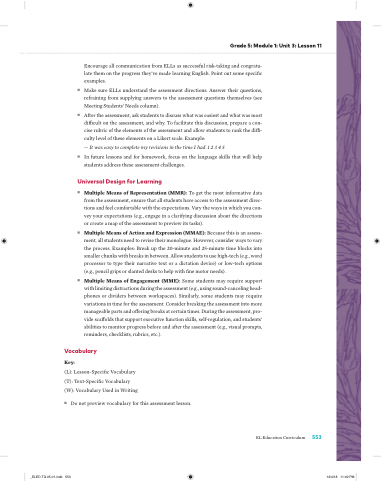Page 577 - EL Grade 5 Teacher Guide
P. 577
Grade 5: Module 1: Unit 3: Lesson 11
Encourage all communication from ELLs as successful risk-taking and congratu- late them on the progress they’ve made learning English. Point out some speci c examples.
■ Make sure ELLs understand the assessment directions. Answer their questions, refraining from supplying answers to the assessment questions themselves (see Meeting Students’ Needs column).
■ After the assessment, ask students to discuss what was easiest and what was most di cult on the assessment, and why. To facilitate this discussion, prepare a con- cise rubric of the elements of the assessment and allow students to rank the di - culty level of these elements on a Likert scale. Example:
— It was easy to complete my revisions in the time I had. 1 2 3 4 5
■ In future lessons and for homework, focus on the language skills that will help
students address these assessment challenges.
Universal Design for Learning
■ Multiple Means of Representation (MMR): To get the most informative data from the assessment, ensure that all students have access to the assessment direc- tions and feel comfortable with the expectations. Vary the ways in which you con- vey your expectations (e.g., engage in a clarifying discussion about the directions or create a map of the assessment to preview its tasks).
■ Multiple Means of Action and Expression (MMAE): Because this is an assess- ment, all students need to revise their monologue. However, consider ways to vary the process. Examples: Break up the 20-minute and 25-minute time blocks into smaller chunks with breaks in between. Allow students to use high-tech (e.g., word processor to type their narrative text or a dictation device) or low-tech options (e.g., pencil grips or slanted desks to help with ne motor needs).
■ Multiple Means of Engagement (MME): Some students may require support with limiting distractions during the assessment (e.g., using sound-canceling head- phones or dividers between workspaces). Similarly, some students may require variations in time for the assessment. Consider breaking the assessment into more manageable parts and o ering breaks at certain times. During the assessment, pro- vide sca olds that support executive function skills, self-regulation, and students’ abilities to monitor progress before and after the assessment (e.g., visual prompts, reminders, checklists, rubrics, etc.).
Vocabulary
Key:
(L): Lesson-Speci c Vocabulary (T): Text-Speci c Vocabulary (W): Vocabulary Used in Writing
■ Do not preview vocabulary for this assessment lesson.
EL Education Curriculum 553
_ELED.TG.05.01.indb 553
12/4/18 11:49 PM


